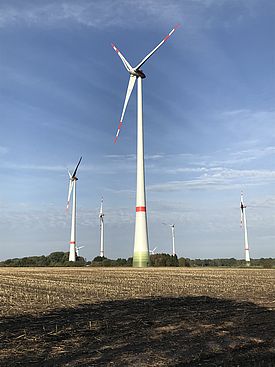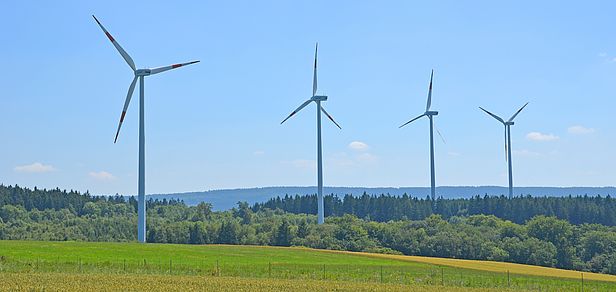11.2.2022 | Stephanie Kusma | News WSL
The construction of large wind turbines often faces opposition. Researchers at the Swiss Federal Institute for Forest, Snow and Landscape Research (WSL) have investigated why this is the case and come up with some ideas for how the planning process could be improved to boost public acceptance.
Renewable energies are valuable and vital: on that much we can all agree. These energies also play a key role in Switzerland's Energy Strategy 2050. In reality, however, actually taking steps to harness renewables (i.e. building the necessary facilities) is often still difficult. Why is this the case? "There are various theories as to why this contradiction exists," says Matthias Buchecker from WSL's Social Sciences in Landscape Research Group.
Large wind turbines can significantly alter the look of a landscape, so for a long time resistance to them was assumed to stem from a kind of 'reflex' against anything that could substantially change people's own neighbourhood. In other words, renewables are vital and useful but 'not in my backyard'.
When perception and plans crash
However, recent research is based on the assumption that this explanation falls short, with the source of opposition to such facilities instead to be found in the public's ties to their local area. If someone feels a close connection or has attached personal significance to a landscape, it is hard for them to imagine it undergoing significant changes, especially if these changes do not fit with their own perception of the landscape and what it means to them.
If this theory is correct, it could herald a promising solution since it may be possible to identify areas where people's perception of the landscape and the image they have of wind turbines actually align. In that case, the turbines would not face opposition from, and might even be welcomed by, the majority of people living in the area.
Rural or urban?

A team comprising Buchecker, his PhD student Stefanie Müller and intern Martina Weber investigated this further by means of an online survey conducted in various municipalities in an area on the outskirts of Bern. A wind farm was being planned in one of these municipalities, but the future locations of the turbines had not yet been set. The team has summarised its findings in a recently published report.
More than 500 people provided information about their perceptions of the various landscapes and areas in which they lived and what they meant to them, answering questions such as: What are the distinguishing features of the municipalities? Do you feel that you live in a rural or urban area? How should the area evolve?
The researchers also asked about attitudes towards the energy transition and how those concerned viewed its implementation at the planning level. Last but not least, the respondents used small-scale maps to plot what they felt were significant areas or areas used by the public where they live, and where a wind turbine could fit in.
Rumours a hindrance
The answer according to the survey findings – or at least an average of all the responses – was 'nowhere really'. "While we were conducting the survey, rumours were already flying about where the turbine was to be built," says Buchecker. And that influenced the responses. "Both those opposed to the turbine and those in favour answered strategically, based on their desired outcome."
While the presumed construction area held significance for both groups, as a recreational space, for instance, when it came to assessing its suitability as a site for a wind turbine, opinions differed. For opponents, the area was sacrosanct and any loss of its significance due to the construction of the turbine was unacceptable. In contrast, supporters claimed that the benefits of the turbine outweighed any possible loss of significance and that the area was a perfectly suitable site.
The earlier the better
"We suspect that the survey took place too late on in the planning process," explains Buchecker. In fact, he says, the survey revealed that "very few of the respondents were satisfied with their involvement in the planning processes". He considers this an important finding of the study. "The public wants to have a say at an earlier stage." However, this would require a fundamental overhaul of the planning processes.
In the survey, those opposed to the turbine rejected any and all changes to their area, not just this particular wind farm. "They felt that they lived in a rural area and were critical of urban development altogether," says Buchecker. "And to them, large wind turbines symbolised such development." His conclusion, therefore, is that the public needed to be involved in the process as soon as questions surrounding the development of an area – whether with regard to the environment, energy, the economy or the landscape – are raised.
The goal must be to find a broad and overarching consensus in which renewable energy facilities would also find their place, explains Buchecker.
Contact
Publications
Projects
Links and documents
Copyright
WSL and SLF provide the artwork for imaging of press articles relating to this media release for free. Transferring and saving the images in image databases and saving of images by third parties is not allowed.
